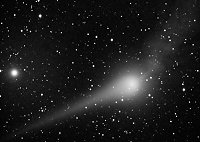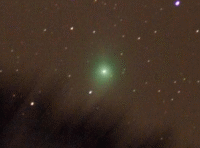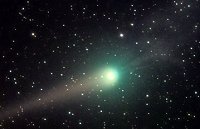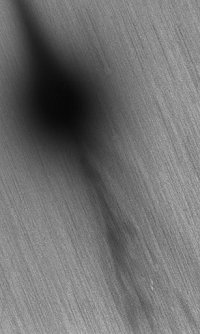| |
VISUAL
REPORTS: "Last night (Feb.21) Comet Lulin
was visible to the naked eye with identical brightness as
star b Vigo HP58510 with a magnitude of 5.35," reports Eddie
Irizarry of the Sociedad de Astronomía del Caribe
in Puerto Rico. "But what caught our attention was Lulin's
noticeable speed. Using a telescope, take a good look at the stars
that surround Comet Lulin; then look again just 10 minutes later
and you will see how Lulin's position has changed. It is amazing
how fast this comet is moving!"
| |
Photographer,
Location |
Images |
Comments |
|

|
Phillip Jones,
Central Texas Astronomical Society observatory grounds, Clifton, TX
Feb. 22, 2009 |
#1,
more |
Comet Lulin captured on Feb 22. The blue anti-tail is beautiful.
|
|

|
Saied Bahrami Nezhad,
Bidkhoon, Kerman, Iran
Feb. 23, 2009 |
#1 |
it was realy
nice. at first i found it by naked-eye in the dark sky,
and after it in the so cold and windy mountains, i decide
to took this picture from the green and lovely comet.
Photo
details: Canon 400D, ISO-1600, 250sec exposure
|
|

|
John Nassr,
Baguio, Philippines
Feb. 22, 2009 |
#1,
more |
Comet Lulin displays a very prominent anti-tail spiking south-east towards the Sun and a tail on the opposite side buffeted by solar winds. Lulin and its two tails span approximately four full moon widths in this 104x155 arc minute field of view.
|
|

|
Jimmy
Westlake,
Stagecoach, Colorado
Feb. 21, 2009 |
#1,
#2, #3,
#4 |
I captured Comet Lulin in
the act of rising over the Rocky Mountains last night, February
21, 2009, in this four-image sequence. As the Earth's horizon
dips down, revealing the green comet and its unusual anti-tail,
the rapid motion of the comet can be seen against the background
stars during the 8-minute time span of the images. Animating
the images brings the comet to life. Relative speed between
the Earth and Comet Lulin is nearly 140,000 MPH as they
move in opposite directions around the Sun!
Image 1 was taken at 8:57 PM MST.
Image 2 was taken at 8:58 PM MST.
Image 3 was taken at 9:02 PM MST.
Image 4 was taken at 9:05 PM MST.
All images were taken with a Fuji FinePix
Pro S2 digital camera (ISO 800) and 300 mm fl Nikkor lens
at f2.8, guided piggyback on a Celestron 11" telescope
in Stagecoach, Colorado.
|
|

|
Paolo Candy,
Cimini Astronomical Observatory - Italy
Feb. 23, 2009 |
#1,
more |
The comet Lulin has a lost of the ion tail, which is like a smoke!
|
|

|
Paul Mortfield,
Sierra Remote Observatories, California, USA
Feb. 20, 2009 |
#1,
#2, more |
I was amazed to find detailed structure in the ion tail by combining 50 frames taken over 100+ minutes. The site's all-sky camera also showed the comet as a faint smudge.
|
more
images:
from
Mike Prokosch of Sam Houston State Observatory, Huntsville,
Texas; from
Tom King of Watauga, Texas; from
Gary W. Kronk of St. Jacob, Illinois; from
Enrico Colzani of Sormano Astronomical Observatory (Co), Italy;
from
Rob Ratkowski of Haleakala summit, Maui; from
Efrain Morales Rivera of Aguadilla, Puerto Rico |
|






